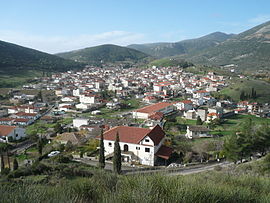Distomo
Municipal unit in Greece From Wikipedia, the free encyclopedia
Municipal unit in Greece From Wikipedia, the free encyclopedia
Distomo (Greek: Δίστομο) is a town in western Boeotia, Greece. Since the 2011 local government reform it is part of the municipality Distomo-Arachova-Antikyra, of which it is the seat and a municipal unit.[2] The municipal unit has an area of 131.270 km2, the community 80.498 km2.[3] Population 3,644 (2021). Distomo is situated in the western foothills of Mount Helicon, at about 450 m elevation. It is 5 km north of the Gulf of Corinth coast, 9 km southeast of Arachova, 12 km east of Desfina, 16 km southeast of Delphi, 18 km west of Livadeia and 105 km northwest of Athens. The Greek National Road 48 (Naupactus - Arachova - Livadeia) passes north of the town.
Distomo
Δίστομο | |
|---|---|
 | |
| Coordinates: 38°26′N 22°40′E | |
| Country | Greece |
| Administrative region | Central Greece |
| Regional unit | Boeotia |
| Municipality | Distomo-Arachova-Antikyra |
| Area | |
| • Municipal unit | 131.27 km2 (50.68 sq mi) |
| • Community | 80.498 km2 (31.080 sq mi) |
| Elevation | 218 m (715 ft) |
| Population (2021)[1] | |
| • Municipal unit | 3,644 |
| • Municipal unit density | 28/km2 (72/sq mi) |
| • Community | 3,085 |
| • Community density | 38/km2 (99/sq mi) |
| Time zone | UTC+2 (EET) |
| • Summer (DST) | UTC+3 (EEST) |
| Vehicle registration | ΒΙ |
| Website | http://www.daa.gov.gr |
Distomo is known as the site of the Distomo massacre that was perpetrated by the German army against the local inhabitants during the Second World War.
One of the most important monuments of Byzantine architecture and a UNESCO World Heritage Site, the monastery of Hosios Loukas is situated close to Distomo.
During the ancient Greek times there was a settlement called Amvryssos (Amvrossos) part of which is buried under Distomo. There is an archaeological museum in Distomo officially called Distomo Archaeological Collection (Wikipidia) with a fine exhibit of ancient pottery and artifacts. The local football/soccer team is also named Amvrysseas after the ancient Greek city.
Aluminium of Greece has its production facilities in the coastal village Agios Nikolaos. Other industries include agriculture and services.
The municipal unit Distomo is subdivided into the following communities (constituent villages in brackets):
| Year | Village population | Community population | Municipal unit population |
|---|---|---|---|
| 1981 | - | - | 5,604 |
| 1991 | 2,156 | - | - |
| 2001 | 2,048 | 3,350 | 4,368 |
| 2011 | 1,589 | 3,192 | 3,881 |
| 2021 | 1,368 | 3,085 | 3,644 |
The ancient Phocean city of Amvrissos (Amvrossos) is located on the site of modern Distomo and its broader area.
On 10 June 1944, Distomo was the site of a massacre of civilians[4] by the Germans, which constituted a war crime. The massacre was meant as "retribution" for the previous death of three Germans at the hands of local guerrillas, even though the villagers had no relation to the guerrillas.
The 4th SS Polizei Division perpetrated grave crimes with superiors encouraging the soldiers. Among them ripping out the intestines of a baby and splattering them on a close relative.
Decades later, a Greek court awarded restitution to Greek victims, but the German government pressed Greece politically to nullify that decision.
To enforce the decision by the Greek court, this case was brought before an Italian court, Greece being unwilling to enforce their own decisions. The judges awarded the plaintiffs the Villa Vigoni in Menaggio, Italy, a German government-sponsored nonprofit foundation. The German government appealed a decision by the Italian supreme civil court for restitutions at the International Court of Justice, claiming for State immunity.
Seamless Wikipedia browsing. On steroids.
Every time you click a link to Wikipedia, Wiktionary or Wikiquote in your browser's search results, it will show the modern Wikiwand interface.
Wikiwand extension is a five stars, simple, with minimum permission required to keep your browsing private, safe and transparent.